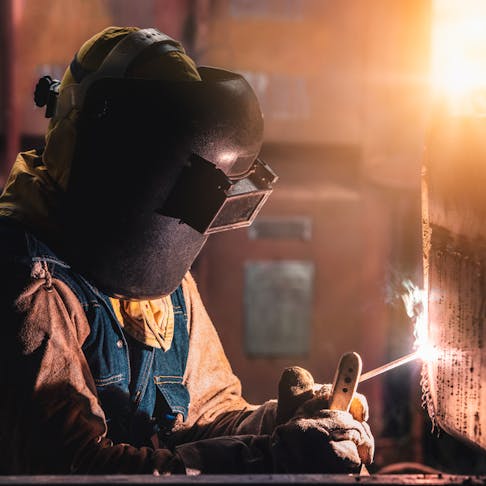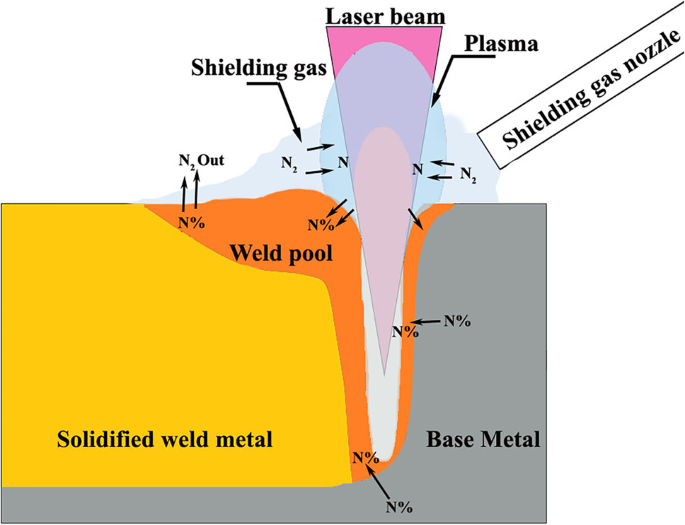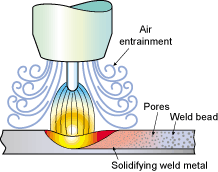UNDERSTANDING POROSITY FORMATION AND PREVENTION WHEN WELDING
Por um escritor misterioso
Last updated 20 maio 2024

Keyhole laser welding is a joining technology characterised by the high focussed power density applied to the workpiece, facilitating deep penetration at high processing speeds. High aspect-ratio welds produced using this process invariably have narrow heat-affected-zones and minimal thermal distortion compared with traditional arc welding processes. Furthermore, the ability to process out of vacuum and the easy robotic manipulation of fibre optically delivered 1?m wavelength laser beams, allow keyhole laser welding to process geometrically complex components. The widespread uptake of keyhole laser welding for the production of titanium alloy components in the aerospace industry has been limited by the stringent weld quality requirements. Producing welds with levels of subsurface weld metal porosity content meeting the required weld quality criteria has been the primary obstacle. Here, three techniques for controlling the levels of weld metal porosity when welding titanium alloys with Nd:YAG rod lasers have been developed. Characterisation of the welding processes using high speed photography and optical spectroscopy, have allowed an original scientific understanding of the effects these methods have on the keyhole, melt pool and vapour plume behaviour. Combining this with a thorough assessment of the weld qualities produced, has enabled the effects of these process behaviours on the formation of weld metal porosity to be determined. It was found that with the correct process parameters a directed gas jet and a dual focus laser welding condition can both be used to reduce the occurrence of keyhole collapse during Nd:YAG laser welding. The directed gas jet prevents the formation of a beam attenuating vapour plume and interacts with the molten metal to produce a stable welding condition, whereas the dual focus laser welding condition reduces fluctuations in the process due to an enlarged keyhole. When applied, both techniques reduced the occurrence of porosity in the weld metal of full penetration butt welds produced in titanium alloys. A modulated Nd:YAG laser output, with the correct waveform and modulation frequency, also reduced the occurrence of porosity in the weld metal compared with welds produced with a continuous-wave output. This was a result of an oscillating wave being set-up in the melt pool which manipulated the keyhole geometry and prevented instabilities in the process being established. In addition, the potential for welding titanium alloys to the required weld quality criteria with state-of-the-art Yb-fibre lasers has been assessed. It was found that the high power densities of suitably focussed laser beams with excellent beam quality, were capable of producing low-porosity full penetration butt welds in titanium alloys without the techniques required for laser beams with a lower beam quality. These new techniques for keyhole laser welding of titanium alloys will encourage the uptake of keyhole laser welding for producing near-net-shape high-performance aerospace components. The advantages offered by this joining technology include high productivity, low heat input and easy robotic automation.

Tips to Prevent Soldering Material Issue

Shielded Metal Arc Welding (SMAW): Definition, How It Works, and Advantages

Keyhole dynamics and porosity generation mechanism at (a) 75 %

Real-time monitoring and control of porosity defects during arc welding of aluminum alloys - ScienceDirect

UNDERSTANDING POROSITY FORMATION AND PREVENTION WHEN WELDING TITANIUM ALLOYS WITH 1 ?m WAVELENGTH LASER BEAMS

Welding Porosity: What It Is & Causes?

The influence of shielding gases on keyhole-induced porosity and nitrogen absorption in SS 304 stainless steel fiber laser welds

Porosity in Welding - Defects / Imperfections in Welds - TWI

The ABC's of Arc Welding, Education Center

Porosity formation mechanism and its prevention in laser lap welding for T-joints - ScienceDirect

Dynamics of solid-liquid interface and porosity formation determined through x-ray phase-contrast in laser welding of pure Al - ScienceDirect
Recomendado para você
-
 SCP 10000 (The Log Cabin) - SECTION 2: SCP 10000 file - Wattpad20 maio 2024
SCP 10000 (The Log Cabin) - SECTION 2: SCP 10000 file - Wattpad20 maio 2024 -
1bhk for rent.. - For Rent: Houses & Apartments - 175055698720 maio 2024
-
Dana White Does Unbelievable Blackjack Split Against Dealer Ace In20 maio 2024
-
 Polaroid Vs. Kodak20 maio 2024
Polaroid Vs. Kodak20 maio 2024 -
Camel - Cap2 Cap3 Call Flows, PDF, Infrastructure20 maio 2024
-
Configuring Destination Tables20 maio 2024
-
 Appartement à vendre Troyes 10000 Aube - 2 pièces 48 m2 à 137150 euros20 maio 2024
Appartement à vendre Troyes 10000 Aube - 2 pièces 48 m2 à 137150 euros20 maio 2024 -
 VOLTME Revo 140W PD3.1 GaN Charger Review - Funky Kit20 maio 2024
VOLTME Revo 140W PD3.1 GaN Charger Review - Funky Kit20 maio 2024 -
Education Catering jobs20 maio 2024
-
 COMPREHENSIVE CATALOG - PDF Free Download20 maio 2024
COMPREHENSIVE CATALOG - PDF Free Download20 maio 2024
você pode gostar
-
 Articles - XPAD by Exeedme20 maio 2024
Articles - XPAD by Exeedme20 maio 2024 -
![fnf font [Roblox] [Mods]](https://images.gamebanana.com/img/ss/mods/62ee2800a58c2.jpg) fnf font [Roblox] [Mods]20 maio 2024
fnf font [Roblox] [Mods]20 maio 2024 -
 Slayers Unleashed breathing - all styles, odds, and unlock levels20 maio 2024
Slayers Unleashed breathing - all styles, odds, and unlock levels20 maio 2024 -
 The Marvels review – bonkers battle for 'quantum bands' in bubblegum sort-of sequel, Movies20 maio 2024
The Marvels review – bonkers battle for 'quantum bands' in bubblegum sort-of sequel, Movies20 maio 2024 -
 5 jogos multiplayer rápidos de baixar para se divertir com os amigos20 maio 2024
5 jogos multiplayer rápidos de baixar para se divertir com os amigos20 maio 2024 -
/i.s3.glbimg.com/v1/AUTH_da025474c0c44edd99332dddb09cabe8/internal_photos/bs/2023/5/F/SyFqFJSUO4xaJ9s9l4Ng/fazenda.jpg) A fazenda 15': Lista tem Rachel Sheherazade, André Gonçalves, ex-Twister, filha de Dudu Nobre e mais20 maio 2024
A fazenda 15': Lista tem Rachel Sheherazade, André Gonçalves, ex-Twister, filha de Dudu Nobre e mais20 maio 2024 -
 New blue lock illustration! : r/BlueLock20 maio 2024
New blue lock illustration! : r/BlueLock20 maio 2024 -
 New Avengers Movies Announced: 'Secret Wars' and 'The Kang Dynasty20 maio 2024
New Avengers Movies Announced: 'Secret Wars' and 'The Kang Dynasty20 maio 2024 -
 Desenho Vetorial Moinho Vento Esboço Desenhado Mão Moinho Isolado20 maio 2024
Desenho Vetorial Moinho Vento Esboço Desenhado Mão Moinho Isolado20 maio 2024 -
 yeacher Kit de pistola de ar HVLP 1.0mm 250cc id Cup Gravity Feed Air Paint er Mini Handheld 360-degree Pistola de pintura para reparação de automóveis Mobiliário Superfície Pintura de Parede Modelos20 maio 2024
yeacher Kit de pistola de ar HVLP 1.0mm 250cc id Cup Gravity Feed Air Paint er Mini Handheld 360-degree Pistola de pintura para reparação de automóveis Mobiliário Superfície Pintura de Parede Modelos20 maio 2024



